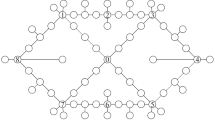Abstract
Motivated by flow allocation in communication and transportation networks we examine user equilibrium and system optimal flows on networks of parallel links. User equilibrium is achieved when the journey times on all the used routes are equal and less than any other unused route. On the other hand the system optimal flow minimizes the average journey times for all used routes. In this paper we study the connection between user equilibrium and system optimums and investigate networks that have identical user equilibrium and system optimal flows. We identify a correspondence between the system optimum of a network and the user equilibrium of the associated Pigovian network and use it to show uniqueness of the system optimum. Using a characterization of Wardrop optimal flows for differentiable convex networks, we show that they are preserved via continuous, strictly increasing and convex functions, uniform increase or decrease of the latency functions and network addition and multiplication.
Access this chapter
Tax calculation will be finalised at checkout
Purchases are for personal use only
Similar content being viewed by others
References
Beckmann, M.J., McGuire, C.B., Winsten, C.B.: Studies in the Economics of Transportation. RAND Corporation (1955)
Dafermos, S., Sparrow, F.: The traffic assignment problem for a general network. J. Res. National Bureau of Standards-B. Math. Sci. 73(2), 91–118 (1969)
Kalampakas, A., Aifantis, E.: Random walk on graphs: an application to the double diffusivity model. Mech. Res. Commun. 43, 101–104 (2012)
Kalampakas, A.: The syntactic complexity of eulerian graphs. Lecture Notes in Computer Science (including subseries Lecture Notes in Artificial Intelligence and Lecture Notes in Bioinformatics) 4728 LNCS, pp. 208–217 (2007)
Kalampakas, A.: Graph automata: The algebraic properties of abelian relational graphoids. Lecture Notes in Computer Science (including subseries Lecture Notes in Artificial Intelligence and Lecture Notes in Bioinformatics) 7020 LNCS, pp. 168–182 (2011)
Kalampakas, A.: Graph automata and graph colorability. Europ. J. Pure Appl. Mathe. 16(1), 112–120 (2023)
Kalampakas, A., Spartalis, S.: Path hypergroupoids: Commutativity and graph connectivity. Europ. J. Combinat. 44(PB), 257–264 (2015)
Kalampakas, A., Spartalis, S., Iliadis, L., Pimenidis, E.: Fuzzy graphs: algebraic structure and syntactic recognition. Artif. Intell. Rev. 42(3), 479–490 (2014)
Kalampakas, A., Spartalis, S., Tsigkas, A.: The path hyperoperation. Analele Stiintifice ale Universitatii Ovidius Constanta, Seria Matematica 22(1), 141–153 (2014)
Kelly, F.P., Maulloo, A.K., Tan, D.K.H.: Rate control for communication networks: shadow prices, proportional fairness and stability. J. Oper. Res. Soci. 49(3), 237–252 (1998)
Low, S., Lapsley, D.: Optimization flow control. i. basic algorithm and convergence. IEEE/ACM Trans. Network.7(6), 861–874 (1999)
Pigou, A.C.: The Economics of Welfare. Macmillan, London (1920)
Saburov, M.: On replicator equations with nonlinear payoff functions defined by the ricker models. Adv. Pure Appl. Math. 12, 39–156 (2021)
Saburov, M.: On discrete-time replicator equations with nonlinear payoff functions. Dyn. Games Appl. 12, 643–661 (2022)
Sanghavi, S., Hajek, B.: Optimal allocation of a divisible good to strategic buyers. In: 2004 43rd IEEE Conference on Decision and Control (CDC) (IEEE Cat. No.04CH37601). vol. 3, pp. 2748–2753 Vol. 3 (2004)
Wardrop, J.G.: Some theoretical aspects of road traffic research. In: Proceedings of the Institute of Civil Engineers, Part II, 1, 325–378 3, pp. 325–362 (1952)
Author information
Authors and Affiliations
Corresponding author
Editor information
Editors and Affiliations
Rights and permissions
Copyright information
© 2023 The Author(s), under exclusive license to Springer Nature Switzerland AG
About this paper
Cite this paper
Kalampakas, A., Bagdasaryan, A., Saburov, M., Spartalis, S. (2023). User Equilibrium and System Optimality Conditions for Flow Distributions on Congested Networks. In: Iliadis, L., Maglogiannis, I., Alonso, S., Jayne, C., Pimenidis, E. (eds) Engineering Applications of Neural Networks. EANN 2023. Communications in Computer and Information Science, vol 1826. Springer, Cham. https://doi.org/10.1007/978-3-031-34204-2_18
Download citation
DOI: https://doi.org/10.1007/978-3-031-34204-2_18
Published:
Publisher Name: Springer, Cham
Print ISBN: 978-3-031-34203-5
Online ISBN: 978-3-031-34204-2
eBook Packages: Computer ScienceComputer Science (R0)




